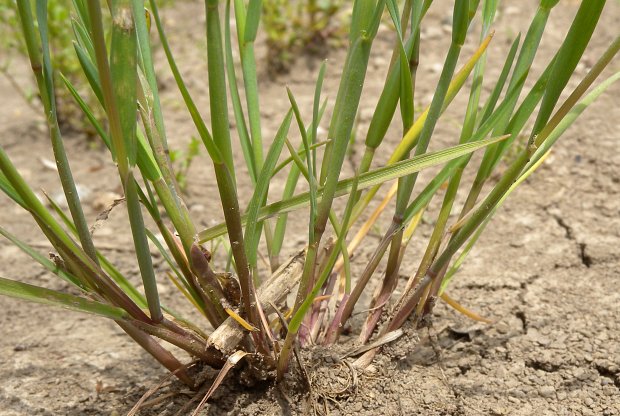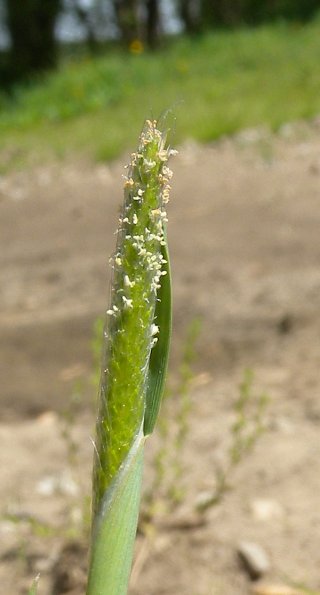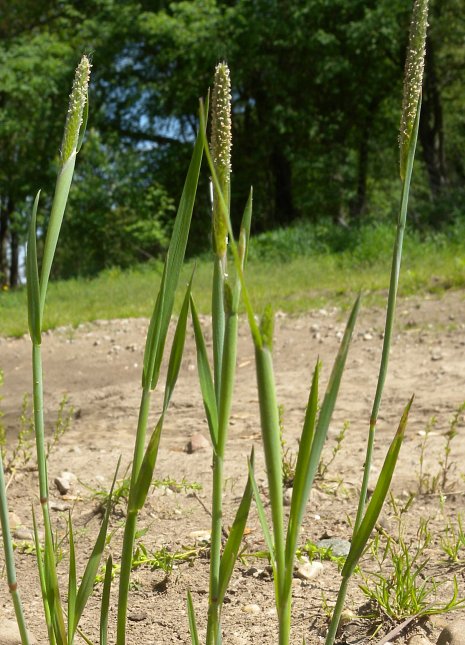Annual
Foxtail
Alopecurus carolinianus
Grass family (Poaceae)
Alopecurus carolinianus
Grass family (Poaceae)
Description:
This grass is a winter or spring annual about 4–20" (10–50 cm.) tall. It often
branches near the base of the plant, producing multiple leafy stems
that are erect to ascending (more erect above than below). The culms
are predominately light green (but sometimes light red toward the
base), terete, hairless, and largely hidden by the leaf sheaths; there
are typically 2-4 leaves along most of the length of each culm. The
leaf sheaths are predominately light-medium green or grayish green
(although lower sheaths are often reddish), longitudinally veined,
hairless, and often rather loose toward their apices. The leaf blades
are medium green on their upper surfaces and light-medium green or
grayish green on their lower surfaces; they are ½–4" (1.5–10 cm.) long, 1–4 mm.
across, hairless, widest at or near the base, and ascending. The
ligules of this grass are white-membranous and its nodes have reddish
rings.

Each culm terminates in an erect spike-like raceme of spikelets about ¾–2" (2–5 cm.) long and 4 mm. across. The scales (glumes and lemmas) of the spikelets are strongly ascending and overlapping along all sides of the raceme. Each spikelet is single-flowered, consisting of a pair of sterile glumes, a single fertile lemma, an ovary with a pair of feathery stigmata, and 3 stamens with white or pale yellow anthers about 0.5 mm. long. The glumes are 2–2.5 mm. long, elliptic and folded along their keels; they are light green to translucent, ciliate along their keels, and softly hairy toward their bases. The fertile lemma is 2–2.5 mm. long, elliptic and convex along its outer side; it is light green to translucent and hairless. The lemma also has a soft awn that originates near its base; it is exserted 1–4 mm. above the spikelet. The blooming period can occur from mid-spring to early summer; it typically lasts about 1–2 weeks for an individual plant. Cross-pollination of the florets is by wind. Afterwards, the spike-like racemes become light tan, and individual spikelets disarticulate below the glumes. The mature grains of the spikelets are typically light tan or light brown, 1–1.5 mm. long, and broadly ellipsoid in shape with one or two flat sides. The root system is shallow and fibrous. This grass reproduces by reseeding itself.

Cultivation: The preference is full sun, moist to wet conditions, and exposed mucky soil that is prone to occasional flooding during spring rains. Most growth and development of this annual grass occurs during the spring when the ground is moist and temperatures are cool. It is somewhat weedy.
Range & Habitat: Annual Foxtail (Alopecurus carolinianus) is native to Illinois and it is found occasionally throughout most of the state. It is least common or absent in the NW section of the state (see Distribution Map). In the United States, this grass is distributed primarily in the Mississippi drainage system of central USA and lower elevations of the Carolinas and Virginia. It is also widely scattered in the western USA. Habitats include lower banks of rivers and streams, exposed ground of disturbed marshes, drainage ditches, and poorly drained areas of fields. Disturbed habitats that are sunny, wet, and with exposed topsoil are strongly preferred.

Faunal Associations: During early spring, the Southern Corn Leaf Beetle (Myochrous denticollis) can migrate and feed on this grass in poorly drained corn fields. Various aphids are known to feed on Foxtail grasses (Alopecurus spp.); see Clark et al. (2004), Robinson & Bradley (1965), and Blackman & Eastop (2013) for more information. The foliage of these grasses are palatable to domesticated livestock, but they are rarely of sufficient abundance to provide an important source of food (Hitchcock, 1950/1971).
Photographic Location: A poorly drained field in Coles County, east-central Illinois.

Comments: This is one of several weedy annual grasses that develop during the spring. It can be distinguished from other similar grasses by its early development, spike-like inflorescences, exserted awns, and reddish rings of its nodes. Compared to the superficially similar Bristle grasses (Setaria spp.), which are also called Foxtail grasses, Annual Foxtail (Alopecurus carolinianus) has more narrow leaf blades and it develops its inflorescence earlier; the inflorescence of Annual Foxtail is also softer to the touch and feels less squiggly when squeezed. Compared to other Foxtail grasses (Alopecurus spp.) that occur in Illinois, Annual Foxtail has shorter lemmas and glumes than Meadow Foxtail (Alopecurus pratensis), while the awns of its lemmas are more exserted and longer than those of Alopecurus aequalis (Short-awned Foxtail). These latter two Alopecurus spp. are also perennial grasses that bloom later in the year. Other common names of Alopecurus carolinianus are Carolina Foxtail and Common Foxtail.

Each culm terminates in an erect spike-like raceme of spikelets about ¾–2" (2–5 cm.) long and 4 mm. across. The scales (glumes and lemmas) of the spikelets are strongly ascending and overlapping along all sides of the raceme. Each spikelet is single-flowered, consisting of a pair of sterile glumes, a single fertile lemma, an ovary with a pair of feathery stigmata, and 3 stamens with white or pale yellow anthers about 0.5 mm. long. The glumes are 2–2.5 mm. long, elliptic and folded along their keels; they are light green to translucent, ciliate along their keels, and softly hairy toward their bases. The fertile lemma is 2–2.5 mm. long, elliptic and convex along its outer side; it is light green to translucent and hairless. The lemma also has a soft awn that originates near its base; it is exserted 1–4 mm. above the spikelet. The blooming period can occur from mid-spring to early summer; it typically lasts about 1–2 weeks for an individual plant. Cross-pollination of the florets is by wind. Afterwards, the spike-like racemes become light tan, and individual spikelets disarticulate below the glumes. The mature grains of the spikelets are typically light tan or light brown, 1–1.5 mm. long, and broadly ellipsoid in shape with one or two flat sides. The root system is shallow and fibrous. This grass reproduces by reseeding itself.

Cultivation: The preference is full sun, moist to wet conditions, and exposed mucky soil that is prone to occasional flooding during spring rains. Most growth and development of this annual grass occurs during the spring when the ground is moist and temperatures are cool. It is somewhat weedy.
Range & Habitat: Annual Foxtail (Alopecurus carolinianus) is native to Illinois and it is found occasionally throughout most of the state. It is least common or absent in the NW section of the state (see Distribution Map). In the United States, this grass is distributed primarily in the Mississippi drainage system of central USA and lower elevations of the Carolinas and Virginia. It is also widely scattered in the western USA. Habitats include lower banks of rivers and streams, exposed ground of disturbed marshes, drainage ditches, and poorly drained areas of fields. Disturbed habitats that are sunny, wet, and with exposed topsoil are strongly preferred.

Faunal Associations: During early spring, the Southern Corn Leaf Beetle (Myochrous denticollis) can migrate and feed on this grass in poorly drained corn fields. Various aphids are known to feed on Foxtail grasses (Alopecurus spp.); see Clark et al. (2004), Robinson & Bradley (1965), and Blackman & Eastop (2013) for more information. The foliage of these grasses are palatable to domesticated livestock, but they are rarely of sufficient abundance to provide an important source of food (Hitchcock, 1950/1971).
Photographic Location: A poorly drained field in Coles County, east-central Illinois.

Comments: This is one of several weedy annual grasses that develop during the spring. It can be distinguished from other similar grasses by its early development, spike-like inflorescences, exserted awns, and reddish rings of its nodes. Compared to the superficially similar Bristle grasses (Setaria spp.), which are also called Foxtail grasses, Annual Foxtail (Alopecurus carolinianus) has more narrow leaf blades and it develops its inflorescence earlier; the inflorescence of Annual Foxtail is also softer to the touch and feels less squiggly when squeezed. Compared to other Foxtail grasses (Alopecurus spp.) that occur in Illinois, Annual Foxtail has shorter lemmas and glumes than Meadow Foxtail (Alopecurus pratensis), while the awns of its lemmas are more exserted and longer than those of Alopecurus aequalis (Short-awned Foxtail). These latter two Alopecurus spp. are also perennial grasses that bloom later in the year. Other common names of Alopecurus carolinianus are Carolina Foxtail and Common Foxtail.